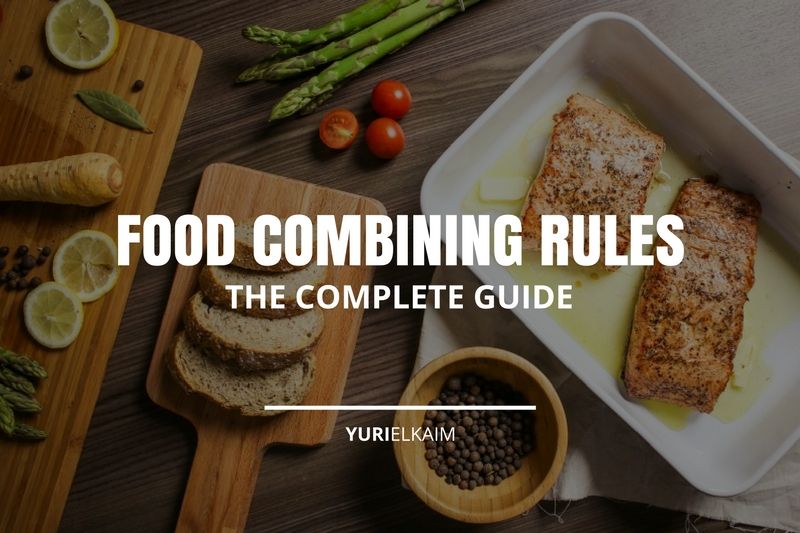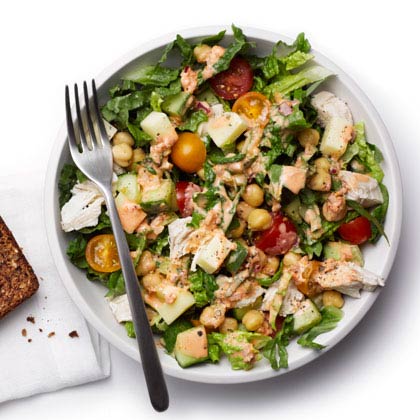In this article
Do you ever feel bloated like a hot air balloon after eating? Or sluggish and heavy?
Many of us do – and even though it’s common, feeling digestive discomfort or fatigue after eating isn’t normal.
In fact, after you eat you should feel energized, refreshed, and ready to take on the world.
So, if you suffer from annoying symptoms that make you regret the last meal you ate, your body might benefit from following some simple food combining rules.
Now, before we get into the details of food combining, I’d like to make a quick disclaimer.
Food combining rules are simply meant to be guidelines for improving digestion, promoting gut health, and easing existing digestive symptoms.
The food combining principles we’re about to discuss aren’t meant to be hard rules to follow for the rest of your life (although you could, if you wanted to).
Instead, food combining rules simply recommend the order in which you eat specific nutrients, to help you better digest and absorb the foods you eat.
What Are Food Combining Rules?
These food combining rules provide a simple approach towards eating, based on the way your body digests specific foods.
Proper food combining can help improve your digestion and assimilation of nutrients, and may even be helpful for those who have a compromised digestive system, or suffer from digestive disorders, such as irritable bowel syndrome (IBS).
Many people have also reported weight loss and clear, glowing skin simply by changing the combinations of foods they eat.
Here’s why these food combining rules can make a difference: each macronutrient (proteins, carbohydrates, and fats) digests at a different speed. Also, each requires the release of different digestive solutions and enzymes to be broken down.
So if you eat foods at the same meal that have opposite digestive requirements, they’re considered bad food combinations. Bad food combinations can result in an intestinal “traffic jam,” which can result in symptoms such as gas, bloating, belching and abdominal cramps.
Acid and Alkaline Enzymes
Let’s take a look at a protein and starch, like a beef burger with a bun.
Protein requires an acidic environment to digest and the digestive enzyme pepsin, while carbohydrates require an alkaline environment and the digestive enzyme, ptyalin (1).
Since beef and bread have opposite digestive requirements, eating them together at the same meal causes the body to release both acid and alkaline solutions.
Acid and alkaline solutions neutralize each other, which can slow down digestion and cause bloating or fatigue.
Improper food combinations can also “confuse” the body, by demanding the body to release several types of digestive enzymes at once. This can further slow down digestion, and cause the infamous post-meal sluggishness by using up even more of the body’s digestive energy.
Understanding food combining rules can also help support the health of your entire gut. When digestive function is slow, food has the opportunity to putrefy and ferment in your digestive tract, which can cause the release of toxins (2).
When food is poorly digested, undigested food particles can also end up in your bloodstream and cause food sensitivities.
Undigested food can also feed the “unfriendly” bacteria in your gut, such as yeast, which can result in digestive conditions like candida.
On the other hand, there are certain foods that combine well together, based on their digest requirements, which we’ll get into in just a moment.
So, what do you think— is food combining just a myth?
Let’s go into more detail about how food combining works, so you can decide for yourself.
How to Start Food Combining For Improved Digestion
These basic food combining rules go hand-in-hand with eating for energy, and are designed to help you steer clear of the discomfort you can feel from poor digestion.
1. Eat Fruit Alone
While there’s nothing better than having a fruity dessert after your meal, combining fruit with other foods is a recipe for digestive disaster. This is because fruit is a simple sugar that digests very rapidly, in roughly 20 to 30 minutes.
Since fruit digests faster than any other food, it’s best eaten alone.
Let’s say, for example, you decided to have a fruit salad with your eggs. Eggs are a protein, which can take between 3 to 4 hours to digest. Since the fruit only takes 20 to 30 minutes to digest, combining it with a protein will create a gastrointestinal (GI) tract traffic jam.
That’s why it’s also best to avoid eating fruit right after meals.
Most people aren’t bothered when they combine fruit with leafy greens or celery since they are mostly water.
But as a general rule, fruit is best eaten alone on an empty stomach so that it doesn’t have the chance to ferment.
Fermentation in your GI tract not only leaves you feeling gassy and bloated, but can also create a feast for unfriendly bacteria.
It’s still important to eat fruit even though it doesn’t combine well with other foods – it’s an excellent source of essential vitamins and minerals that we need for healthy cells, energy and digestive function.
Now, there are exceptions to every rule, including eating fruit alone.
Blending (think smoothies) “pre-digests” the ingredients, so fruit can be combined with other nutrients in smoothies, such as healthy fats from hemp hearts, chia seeds, avocado or plant protein.
So, why not get your daily fruit fix with a green smoothie each morning? One of my favorites is this Red Velvet Smoothie.
2. Pair Protein with Non-Starchy Vegetables
We’ve already covered the basics of protein digestion, so I’ll keep it short and sweet here.
As you now know, in order to be digested, protein needs an acidic environment, which is why it’s considered a bad food combination to eat protein with starches.
However, protein can be paired with leafy greens and other high-water-content vegetables, such as asparagus, peppers, celery or broccoli.
Since these vegetables are rich in their own enzymes, they don’t require an alkaline environment for digestion.
As a result, they don’t interfere with the acidic environment required by protein.
Good protein combinations include:
- Wild salmon + broccoli + green beans
- Organic chicken + sauteed kale + mashed cauliflower
- Organic ground turkey + sauteed bell peppers, onions and swiss chard
Now, we’ve mostly talked about animal protein, but the same food combining rules apply to plant proteins, such as beans and legumes.
While I don’t typically recommend including soy products in your diet, all plant proteins follow the same food combining rules as animal protein.
3. Pair Starches with Healthy Fats and Vegetables
Asian Quinoa Mason Jar Salad
Starches (like brown rice and quinoa), along with starchy vegetables (such as sweet potatoes and squash), need an alkaline environment for digestion.
For this reason, starches combine best when eaten together – for example, brown rice or quinoa and sweet potatoes. Since non-starchy vegetables and leafy greens are considered neutral, they can also combine well with starches.
But wait … aren’t beans and legumes considered a starch?
Beans and legumes are a trickier food to categorize under food combining rules because they contain both protein and starch, which in itself is an improper food combination.
But since they’re primarily considered a starch, it’s suggested beans and legumes digest best with vegetables and other starches, such as brown rice.
Proper food combining with starches would look like:
- Quinoa + avocado + ½ baked potato drizzled with organic butter
- Lentil soup with vegetable broth + mixed veggies
- Homemade yam fries + olive oil + parsley
- Brown rice bowl + veggies sauteed in coconut oil + vegetable broth
4. Leafy Greens and Non-Starchy Vegetables Go with Everything
As we covered earlier, leafy greens and non-starchy vegetables contain their own digestive enzymes, and can be paired with any food combination without causing a traffic jam in your GI tract.
Now, if you want to be methodical with your food combining, you could eat your leafy greens first before moving on to the rest of your plate.
This is because leafy greens digest quicker than proteins, starches and fats. But unlike fruit, they aren’t high enough in natural sugars to create a major GI tract traffic jam.
So when in doubt about food combining rules, simply choose to eat a single macronutrient (a protein, starch or healthy fat) with a leafy green or non-starchy vegetable.
5. Drink Water Away From Meals
Another food combining rule for better digestion is to avoid drinking large sips of cold water with your meals.
Water can dilute your digestive fluids, which can slow down digestion. Instead, it’s best to have small sips of room temperature water with your meals, and focus on drinking the majority of your daily water intake away from meals.
You can support your overall digestive process by drinking a glass of lemon water roughly 20 minutes before a meal. Lemon contains ascorbic acid, which can help stimulate digestion.
If you want to take your digestive function to the next level, you may also want to add a teaspoon of apple cider vinegar to your lemon water, like with this Hawaiian Apple Cider Vinegar Drink.
Apple cider vinegar is so beneficial to digestion because it contains acetic acid. Acetic acid mimics stomach acid, which is why it can help improve poor or weakened digestion. Acetic acid has also been shown to improve calcium and magnesium absorption (3).
6. Spices, Herbs and Citrus Are Neutral
Spices and herbs like ginger, garlic, turmeric, apple cider vinegar, mustard, curry powder – along with and citrus fruits such as lemon and lime – are all considered neutral. They form proper food combinations when paired with a protein, fruit, starch or healthy fat.
Any spice or herb can be used to jazz up your favorite recipes, such as ginger in your Detox Green Juices, or lemon and apple cider vinegar on your Detox Greens Salad.
7. Minimalist Meals Digest Best
If you ever forget the specifics of these food combining rules, just remember that meals with fewer ingredients digest the best because they require fewer enzymes.
So, when in doubt, choose one major macronutrient and pair it with a non-starchy vegetable or leafy green— and remember to always eat fruit alone, at least twenty minutes before a meal.
Minimalist meals are also easy to order at restaurants, or anywhere else you might go to eat.
For example:
- Scrambled eggs + mushrooms + spinach
- Rye flaxseed toast + grassfed butter or coconut oil + avocado
- Grilled veggie sandwich on whole grain bread + Dijon mustard + sprouts
As you can see, food combining rules may seem complicated at first, but they’re simple to follow when it comes down to the basic concept of eating macronutrients separately from one another.
But again, you don’t have to become fanatical about food combining rules. Instead, keep them in the back of your mind – especially if you have digestive and gut issues, which may be resolved by making things a bit easier to digest through proper food combinations.
Listen to the Cues
Next time you experience digestive distress, don’t forget to take note of what foods were on your plate to see if a bad food combination was to blame.
As you begin to follow proper food combining rules, I can guarantee you’ll start to notice a positive shift in your energy levels, digestion and overall well-being.
So, why not give food combining a try, and see what magic it can work for your health?
Banish Bloat Fast
Want to feel better by tomorrow? You can “cleanse” it without depriving yourself in less than 24 hours.
My 1-Day Detox plan includes mouthwatering meals that will leave you feeling leaner and more energized.
You can get the program – for FREE! – by clicking the banner below, and start feeling great by tomorrow.








